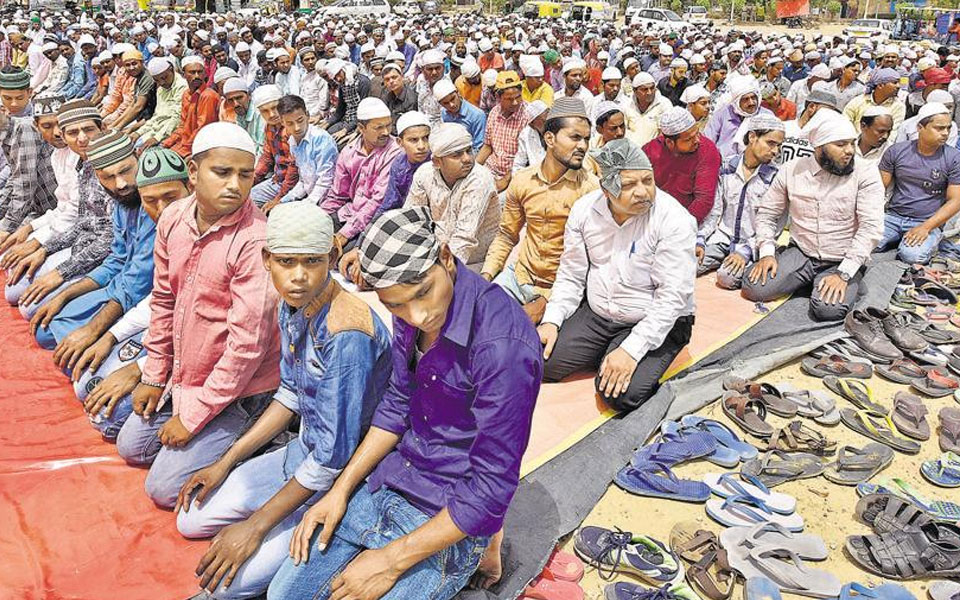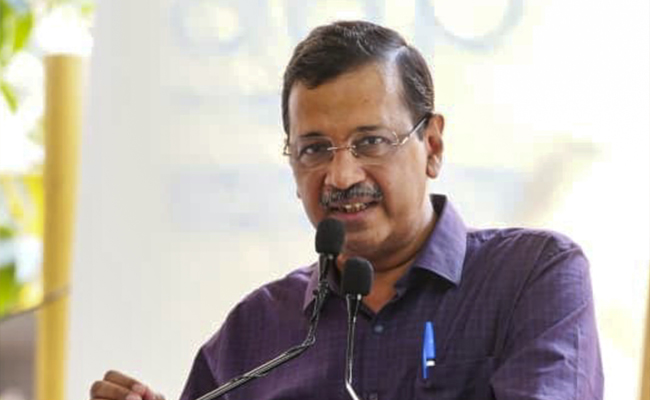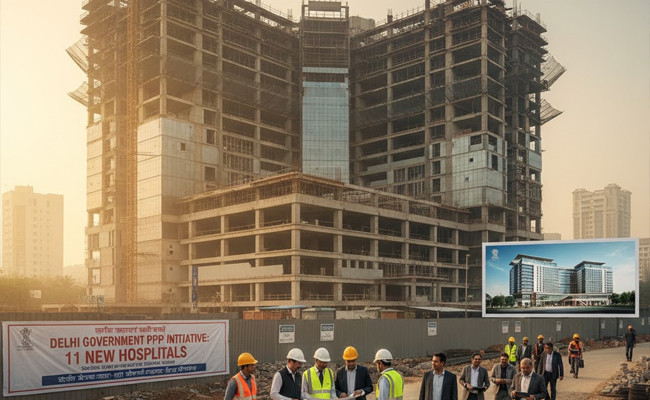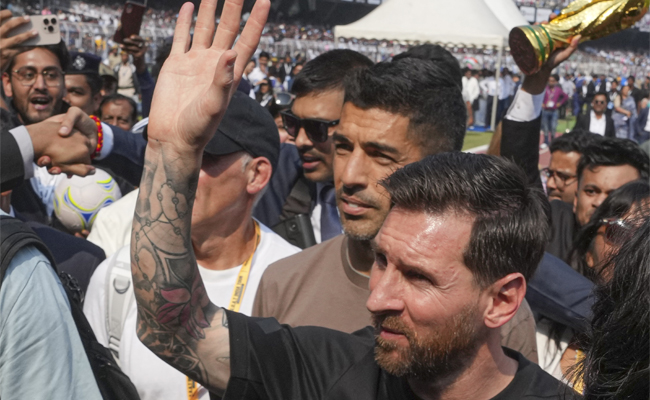On 10 June, a Hindu priest and his followers met at a budget bar in Gurugram (previously Gurgaon) to declare war on Muslims. The alcohol had been replaced by a vegetarian buffet, the doors and windows thrown open to light up the dark interior, the tables and chairs rearranged to host a press conference, but the smell of cheap whiskey remained thick in the air.
Ignoring the inappropriate setting, Narsinghanand Saraswati stared hard at the collected members of the press and made his urgent announcement: “We are about to launch a revolution on the land of Gurgaon.” Just out of arrest for trying to set himself on fire in front of Haryana’s chief minister’s residence to protest public namaz in Gurugram, Sawaswati said he was going to organise a maha havan in the city to “destroy the enemies of Hindus.” The president of All India Saints Council, Saraswati, who has built an army of 15,000 young Hindus to fight ISIS, was asked by journalists if he is counting on the support of the Bharatiya Janata Party in his “revolution”.
He fulminated in response. “No political party can save us. Advani ji is too old, retired. Modi ji hasn’t done anything for Hindus in four years to inspire any faith. I don’t know whether Yogi ji is with us or not anymore.” He said all he needed are young Hindus burning with anger, “Our motto should be: Gita in one hand and Gun in another.”
Living and Dying for Hindus
Sitting on his left, young and muscular Amit Hindu twirled his goatee. A wrestler trained in his village’s Rashtriya Swayamsevak Sangh akhada, the 23-year-old, who insists that he be known by his chosen last name, said he had only goal in life: “to live for Hindus and to die for Hindus.” This is what he used to do all day with a bunch of unemployed friends, each affiliated with a local Hindu organisation, in an empty ground near his village, Kanhai, in Gurugram’s Sector 53. “We used to treat the space as our office. We discussed problems, like the smuggling of cows, and came up with plan of action,” he said. This land was their turf for every day of the week except Friday when Muslims gathered there to offer the afternoon’s namaz. It made them very angry.
On April 20, eight or ten young men from two villages, Kanhai and Wazirabad, rode their motorbikes to the public ground just as the Muslims were about to start their prayers and asked them to pack up, leave, and never return. Yelling ‘Jai Shri Ram’, the young men spread through the crowd of worshippers and spelt out consequences. Shot on a mobile phone, a video of the incident became instantly viral (“five lakh searches in five days”) and sparked off similar disruptions of namaz all over Gurugram the following Friday. On April 27, Sector 53’s police arrested six friends of Amit for outraging religions feelings, disturbing religious worship and criminal intimidation. They were let out on bail three days later.
By June 10, two of them had been arrested and released again. “They had a fight with someone and busted his head,” Arvind Dahiya, the officer in charge of the police station, said. The young men keep making trouble, he added. “If it’s not Muslims, it will be someone else. Most of them are in and out of jail.”
Going to jail doesn’t make anyone a criminal, argued Sube Singh Bohra, the ex-headman of Wazirabad and the father of BJP’s councillor from the village, who rallied Gurugram’s administration for the bail out of the six young men. Holding out a plate of homemade sweets, the village patriarch proceeded to offer a series of justifications on their behalf.
“BJP’s president Amit Shah was also in jail on criminal charges. It doesn’t mean anything.”
“I just got out on bail myself. I had been arrested for threatening the police commissioner of Gurugram.”
“What do you think happens in any fight? You either break someone’s head or someone breaks your head.”
A member of the newly formed Sanyukt Hindu Sangarsh Samiti, an umbrella organisation for Gurugram’s vast network of Hindu-interest groups, Bohra said the rising number of Muslim migrants in the villages left the native Hindus with no other option but to fight for survival. “Otherwise a day will come when we will cease to exist”. In his own village, he later mentioned, Muslims made up less than 2 percent of the population.
“This city is sitting over barrels of gunpowder,” said Rajeev Mittal, a leading light of the Sanyukt Hindu Sangarsh Samiti. “Sparks have been flying across the two sides. The matter has been under control because of the tolerance of Hindus, but things can blow up any day,” he said. “Our own Muslims we can live with, but the majority of Muslims arriving in Gurugram are from Bangladesh. All of them undocumented. Most of them Rohingyas,” he said, checking his phone for alerts from WhatsApp groups buzzing with Hindu solidarity. The Gurugram police deny the presence of undocumented migrants from Bangladesh in the city. Official denials do not rattle Rajeev Mittal, however. “It is not a small issue,” he maintained. “These people aren’t worthy of living in civilized society by nature or by behavior. Do you know that Rohingyas burn people alive and eat their flesh?”
Being Muslim in Gurgaon
A native of Nadia district in West Bengal, Akbar Ali can live on fish curry. It’s what he has been cooking every day for a living since he left his village ten years ago. Two months ago, he left his cooking job in Mumbai to join his uncle’s restaurant in Sector 49’s Bengali Market in Gurgaon. The market caters to the needs of blue-collar migrants from West Bengal who provide their services to white-collar residents of South City, one of Gurugram’s many private townships, as maids, cooks, drivers, security guards and construction workers. Dozens of people from Nadia live in Ali’s tenement; hundreds from other districts live around Bengali Market; and thousands from his state live in the backyards of shopping malls, gated colonies, and private townships across Gurugram’s newly developed sectors. Akbar Ali has an Aadhaar card of which one copy remains in the possession of his landlord. He is happy to not live in one of Gurugram’s migrant ghettos where the landlords affix the renters’ identification papers to the gates.
However, the right to privacy isn’t as big a concern for him and his people as the right to offer namaz in the vicinity of their homes or workplaces.
Of Gurugram’s ten official mosques, eight lie in the older areas and remain largely inaccessible to the Muslim migrants settled on the other end of the district. Some travel the long distance nevertheless. Many of them head to their nearest empty ground --park, pavement, parking lot-- during lunch time on Fridays. Ali doesn’t have many options himself. He could pray inside the tin shed put up in the middle of the market by fellow shopkeepers, but its surfaces sizzle in the summer. For now, he travels in his uncle’s auto rickshaw to New Gurugram’s only (unfinished) mosque in Sector 57 where thousands of Muslims offer namaz in four shifts every Friday.
“There must at least be at least 100,000 Muslims offering namaz every Friday if 500,000 are estimated to live in Gurugram,” said Altaf Ahmed, an entrepreneur who lives in a gated colony. For years he offered Friday’s prayers in an open space in Sector 45. “I used to work in Unitech’s Cyber Park in Sector 39 and it was the closest public space available near my office. Most people who prayed there were office-goers,” he said.
Responding to pressure from the Sanyukt Hindu Sangarsh Samiti, the district authorities reduced the number of approved public sites for namaz from 73 to 37. “People are not offering namaz in open by choice. Just try offering namaz under the sun for half an hour. You will know. We are not asking anyone to give us space for free. Assign us land where we can build mosques,” Ahmed said.
A Divided City
Having lived in Gurugram for 11 years, Ahmed said that even his privilege doesn’t shield him from the petty prejudices bubbling under the city’s cosmopolitan facade. “In the offices, Muslims don’t want to bring up their Muslimness to the table. They know the perception others have of them: we marry several times, we eat meat from morning to night, our wives wear burqas and our fathers keep beards,” he said. “In her posh school, my daughter is asked, ‘are you from Pakistan?’ She is too young to even know what Pakistan is.”
Gurugram, argues Radha Khan, a resident of the “millenium city” for the past ten years, is a “place built for Hindus.” The social inclusion consultant asks how a place that thrives on migrants can call itself city when it can’t accommodate their religious diversity. “Where are the mosques, the churches, the gurudwaras?” To feel Gurugram’s Hindu dominance, she said, one needn’t venture out of their high-rise apartment. “Hindu festivals are publicly celebrated, from karva chauth to krishnashtami. Space is cleared for people to play with colours on Holi or burst crackers on Diwali. Cultural performances are organised. In a Resident Welfare Association (RWA) meeting that my husband once attended, the proposal to build a temple came up, but it was later vetoed.”
On Eid, though, she said, Muslim residents wonder if wishing each other openly is too loud an expression of their religious identity. “Muslims in these housing societies are increasingly aware of the constraints under which they live. Many of them no longer carry meat from the markets for the fear of being branded as beef eaters but order it home from supermarkets.”
At Wellington Estate, a housing society in DLF’s Phase 5, only 1 or 2 percent of the residents are Muslims, said Ajay Jain, the secretary of its RWA. He briskly added that 99 percent of maids and cooks who work in the society are “Mohammedan ladies. Mostly Bengali.” Almost all of them, he mentioned, go by Hindu names. It keeps things simpler, he explained. Jain doesn’t think the lack of namaz space for a society’s residents or their staff should be an RWA concern. The issue wouldn’t have come up in the first place, he argued, if Muslims didn’t insist on praying in public. “Don’t the Hindu residents carry on with their bhajan-kirtan inside their homes?”
When historian Veena Oldenburg hired a maid for her house in Phase 3 of DLF’s Cyber City 13 years ago, she knew her as Usha. “Later, she revealed that she is Kohinoor. It’s a common story. No one will give them a job in the city if they identify themselves as Muslim,” she said. Irrespective of the discrimination they face in the city, Bengali migrants continue to pour into Gurugram in search of opportunity. “First Kohinoor came with only her daughter. Thirty of her relatives have joined her since: three sisters, two brothers, their mother,” said Oldenburg who has been researching Gurugram’s history for over a decade.
All About Land
The region has no deep-rooted history of communal tension, Oldenburg mentioned, because it has had few Muslims until a few years ago. “It being a Hindu-dominated society, the tension among communities was based on caste. Khap panchayats ruled on social conflicts and their focus was on controlling the women.” The arrival of Muslims has changed the social dynamic of the villages, Oldenburg argued.
Like most things in Gurugram, this too revolves around land.
“Gurugram’s development began with villagers selling and leasing their land. Some landowners sold their land and suddenly had more money than they had ever seen. Some drank it away, others bought big cars, went on big holidays, threw lavish weddings. Several went broke. They remain uneducated, unskilled, but they have a chip on their shoulder about having owned land in the past. They are the core of the bloodthirsty lot who hate any intrusion into their villages. They have nothing to rent out. They mark out poor migrants,” said Oldenburg.
Then she described a different kind of Gurugram’s landowners.
“They did better. Some sold their land and re-invested the money into the property business. Some went into partnerships with real-estate companies. Others held on to a portion of their land and built multi-storey tenement houses with basic rooms and common bathrooms to rent out to labourers arriving to build the new Gurugram. They don’t want the migrants to be driven away.”
War And Peace
The conflict between their interests came to a head with the row over public namaz. On May 27, after two weeks of namaz disruptions, 200 people representing different faiths from 360 villages of the district convened at a mahapanchayat to call for communal harmony to keep alive “the cosmopolitan culture of the international city.”
“When I went village to village mobilising support, the villagers spoke about their anxieties,” said Pradeep Zaildar, a Congress leader. “Gurugram’s development has brought in companies and companies have brought in migrants, who live on their property and work in their remaining farms. They are afraid that if the communal incidents persist, the companies will leave Gurugram, its progress will stop, and they will end up starving. They have no option but to come together.”
On 10 June, hours after the “Hindu revolution” was “launched” in Sector 10,” Zaildar repeated the call for peace at an “interfaith iftar” organised to resist Gurugram’s polarisation in Sector 27. “We can’t allow ourselves to be scared by this intimidation. We must come together and fight. This evening is a slap in their faces,” Mohammed Amin, a factory worker from Manesar, called out to the city’s secular citizens in one of the speeches. “I have lived in a bubble for far too long,” said Rita Jain, an optician circulating plates of fruit around the hall. For a few years now, my clients have been making divisive statements such as, ‘this is my country. We can accomodate Muslims but they must know their place.’ I can’t sit and listen anymore.”
“This isn’t going to change the world, said Veena Oldenburg, “but there was a message and it went out.”
It may not be enough to stop the agitating Hindus in their tracks. Amit Hindu said his group would prevent namaz being offered in public after the month of Ramzan that ended in mid-June. On 29 June, a group of Muslims were stopped from reading namaz in a vacant plot in DLF Phase 3. An officer at the local police station said they had received a complaint alleging misuse of public land. A similar incident was reported from Sector 34 on the same day.
Regardless of the disruptions, Altaf Ahmed said the city’s secular community will continue to push for their rights. “We will put up a united front against them.”
courtesy : hindustantimes.com
Let the Truth be known. If you read VB and like VB, please be a VB Supporter and Help us deliver the Truth to one and all.
Panaji (PTI): As part of a crackdown against tourist establishments violating laws and safety norms in the aftermath of the Arpora fire tragedy, Goa authorities on Saturday sealed a renowned club at Vagator and revoked the fire department NOC of another club.
Cafe CO2 Goa, located on a cliff overlooking the Arabian Sea at Vagator beach in North Goa, was sealed. The move came two days after Goya Club, also in Vagator, was shut down for alleged violations of rules.
Elsewhere, campaigning for local body polls, AAP leader Arvind Kejriwal said the fire incident at Birch by Romeo Lane nightclub at Arpora, which claimed 25 lives on December 6, happened because the BJP government in the state was corrupt.
An inspection of Cafe CO2 Goa by a state government-appointed team revealed that the establishment, with a seating capacity of 250, did not possess a no-objection certificate (NOC) of the Fire and Emergency Services Department. The club, which sits atop Ozrant Cliff, also did not have structural stability, the team found.
The Fire and Emergency Services on Saturday also revoked the NOC issued to Diaz Pool Club and Bar at Anjuna as the fire extinguishers installed in the establishment were found to be inadequate, said divisional fire officer Shripad Gawas.
A notice was issued to Nitin Wadhwa, the partner of the club, he said in the order.
Campaigning at Chimbel village near Panaji in support of his party's Zilla Panchayat election candidate, Aam Aadmi Party leader Kejriwal said the nightclub fire at Arpora happened because of the "corruption of the Pramod Sawant-led state government."
"Why this fire incident happened? I read in the newspapers that the nightclub had no occupancy certificate, no building licence, no excise licence, no construction licence or trade licence. The entire club was illegal but still it was going on," he said.
"How could it go on? Couldn't Pramod Sawant or anyone else see it? I was told that hafta (bribe) was being paid," the former Delhi chief minister said.
A person can not work without bribing officials in the coastal state, Kejriwal said, alleging that officers, MLAs and even ministers are accepting bribes.





